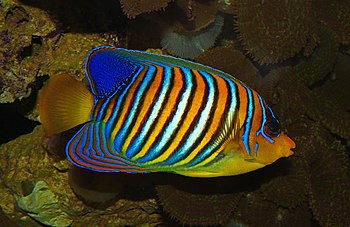 |
| Corydoras Panda - (CC) Wikimedia |
The Corydoras catfish is a member of the family Callichthyidae. They are from the genus Corydoras. There are several different species of Corydoras. They all share similar traits such as body size, shape and behavioral habits. The distinguishing feature between the various species is their color palette, some of which are quite striking.
Catfish are bottom-dwelling scavengers. Scavenger fish generally have two traits in common. Their mouths are usually pointed downward. And the mouth has barbels on either side. A barbell is a tentacle-like organ that contains taste buds. They are used to find food and to feel their way around on riverbed floors in the wild. The Corydoras catfish has two barbells, one on either side of its mouth.
Corydoras catfish are often referred to as armored catfish. This is because they have two rows of bony plates on each side of their body.
Unlike most scavenger fish, the Corydoras catfish is not strictly a bottom dweller. The Corydoras is part of the Anabantoidei suborder. This means that although they do have gills, they require both atmospheric and dissolved oxygen in order to survive. Anabantoids or labyrinth fishes have a lung-like organ that allows them to consume airborne oxygen. The Corydoras catfish will frequently rise to the surface of the water to gulp in needed air.
The Corydoras catfish is a relatively small freshwater fish. When fully grown, they only reach a size of between two to three inches. The dwarf corydoras or Corydoras pygmaeus is even smaller, reaching only about one inch in length.
Corydoras catfish make great additions to community fish tanks. They have a docile temperament. And they do a great job of cleaning up food particles from aquarium substrate to help in the prevention of harmful bacteriological build-up.
Although Corydoras are primarily bottom dwellers, they are shoaling fish. They tend to congregate together in aquariums. They even search for food and rest together. It is not at all uncommon to see one catfish resting his head on the body of another catfish. The catfish do not necessarily even have to be the same species as long as they are of the genus Corydoras. Because of their social nature, you should add at least two or three to your tank. Corydoras are not meant to live a solitary existence.
Corydoras are omnivores. They will eat just about anything they come across on the aquarium floor. Sinking foods work best to ensure your Corydoras get their required food allotment. Unlike most bottom dwellers, Corydoras have been known to rise to the surface to eat foods such as freeze-dried worms. This may be because they need to periodically rise to the surface to take in atmospheric oxygen.
Corydoras are native to the rivers and streams of South America. They thrive in neutral water (pH of 7.0) in temperatures between 70-79 degrees Fahrenheit.
You want to use sand or rounded gravel as a substrate when keeping Corydoras to help prevent them from damaging their barbels.
It is not easy to distinguish between males and females. Generally, the females' bodies are a little wider than that of the males.
Breeding Corydoras Catfish
The Corydoras have some of the most peculiar mating habits found among freshwater fish. They spawn in groups of three (1 female to 2 males), usually assuming a T position. The female places her mouth against the male's genital opening and swallows some sperm. The sperm passes through her body rapidly and out onto the eggs she has just released. The female then carries the eggs with her ventral fin to a flat surface in the breeding tank and sticks them there until they hatch.
After spawning has occurred, the adult should be removed from the breeding tank. The fry will hatch in a few days.
Fry can be fed liquid fish fry food. When they get a little older their diet can be changed to newly hatched brine shrimp and then finely crushed fish flakes.
Aquarium keeping is a fun and rewarding hobby. Freshwater aquarium fish care is the easiest and most economical way to enter the field of aquarium ownership. Less than a decade ago freshwater or saltwater fish were the only options available. But that has all changed.
|






